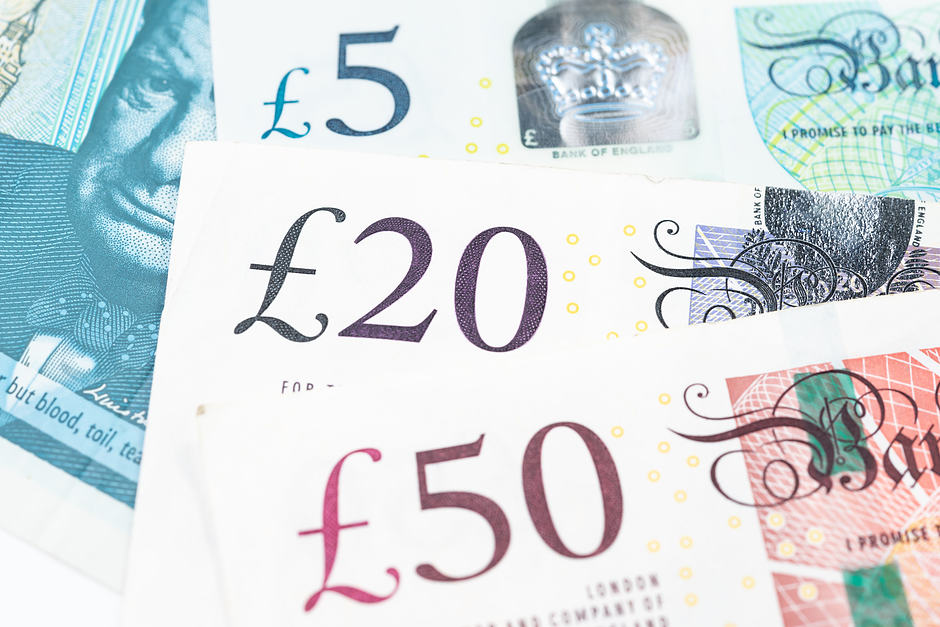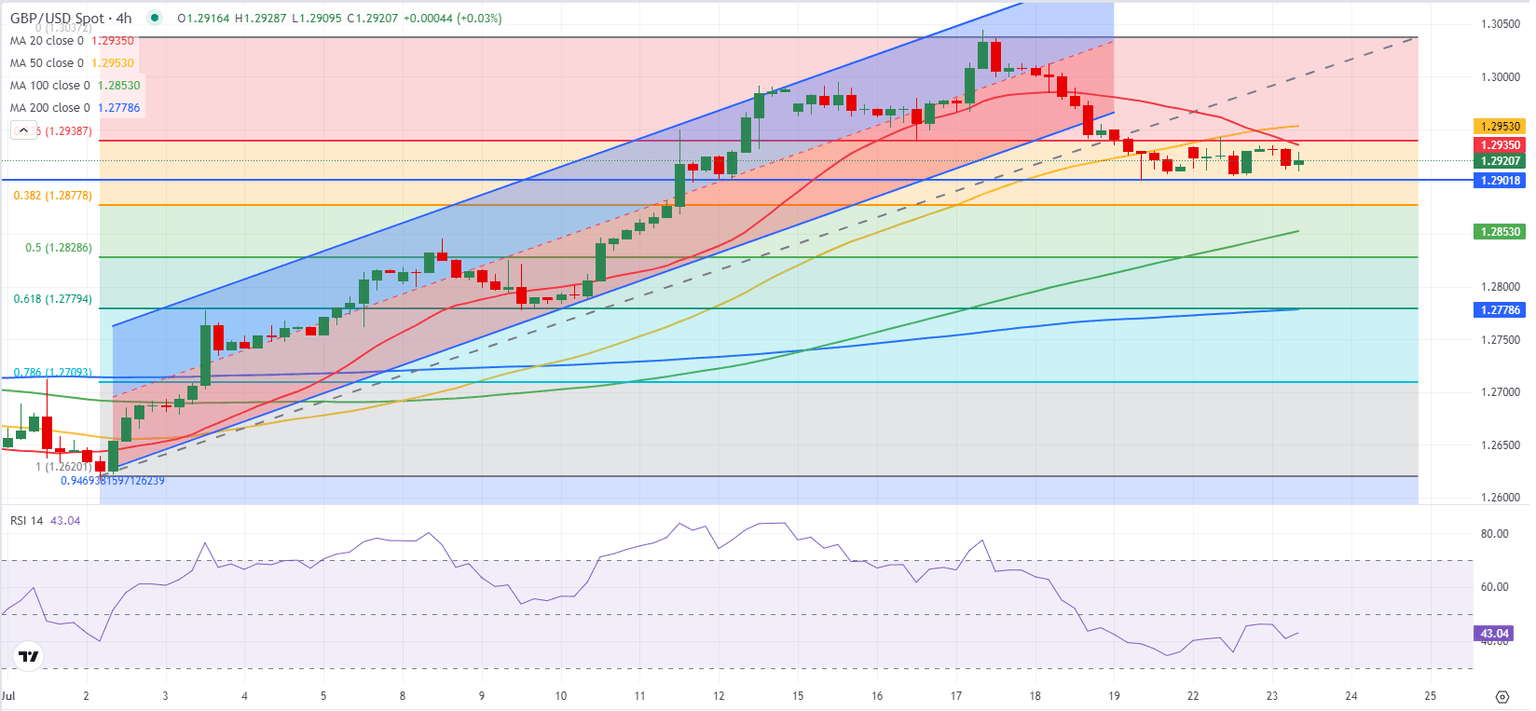GBP/USD Forecast: Pound Sterling extends sideways grind above 1.2900
- GBP/USD continues to trade in a narrow channel above 1.2900.
- The near-term technical outlook points to a slightly bearish bias.
- Changes in risk perception could drive the pair's action later in the day.

Following the sharp drop seen in the second half of the previous week, GBP/USD registered small gains on Monday. The pair struggles to attract bulls early Tuesday but manages to hold above 1.2900.
British Pound PRICE Last 7 days
The table below shows the percentage change of British Pound (GBP) against listed major currencies last 7 days. British Pound was the weakest against the Japanese Yen.
| USD | EUR | GBP | JPY | CAD | AUD | NZD | CHF | |
|---|---|---|---|---|---|---|---|---|
| USD | 0.19% | 0.36% | -1.31% | 0.60% | 2.03% | 1.86% | -0.60% | |
| EUR | -0.19% | 0.16% | -1.49% | 0.43% | 1.82% | 1.65% | -0.80% | |
| GBP | -0.36% | -0.16% | -1.67% | 0.24% | 1.66% | 1.49% | -0.95% | |
| JPY | 1.31% | 1.49% | 1.67% | 1.93% | 3.43% | 3.22% | 0.76% | |
| CAD | -0.60% | -0.43% | -0.24% | -1.93% | 1.43% | 1.24% | -1.19% | |
| AUD | -2.03% | -1.82% | -1.66% | -3.43% | -1.43% | -0.19% | -2.60% | |
| NZD | -1.86% | -1.65% | -1.49% | -3.22% | -1.24% | 0.19% | -2.41% | |
| CHF | 0.60% | 0.80% | 0.95% | -0.76% | 1.19% | 2.60% | 2.41% |
The heat map shows percentage changes of major currencies against each other. The base currency is picked from the left column, while the quote currency is picked from the top row. For example, if you pick the British Pound from the left column and move along the horizontal line to the US Dollar, the percentage change displayed in the box will represent GBP (base)/USD (quote).
The improving risk mood caused the US Dollar (USD) to lose interest in the American session on Monday, helping GBP/USD hold its ground. In the European session on Tuesday, the UK's FTSE 100 Index trades marginally lower on the day and US stock index futures lose between 0.1% and 0.4%, reflecting a cautious market stance.
After Wall Street's closing bell on Tuesday, Google (Alphabet), Visa and Tesla will be among the top companies that will release second-quarter earnings reports. Investors could opt to stay on the sidelines and make it difficult for major US equity indexes to build on Monday's gains. In this scenario, the USD could stabilize and limit GBP/USD recovery attempts.
Existing Home Sales for June will be the only data featured in the US economic docket on Tuesday, which is unlikely to receive a noticeable market reaction. On Wednesday, preliminary July Manufacturing and Services PMI data from the UK and the US could trigger the next big action in GBP/USD.
GBP/USD Technical Analysis
GBP/USD stays below the 20-period Simple Moving Average (SMA) and the 50-period SMA on the four-char, which made a bearish cross on Monday. Additionally, the Relative Strength Index moves sideways near 40, suggesting that the bearish bias remains intact but lacks momentum.
1.2900 (psychological level, static level) aligns as first support before 1.2875 (Fibonacci 38.2% retracement of the latest uptrend) and 1.2850 (100-period SMA).
On the upside, 1.2940-1.2950 (Fibonacci 23.6% retracement, 50-period SMA) forms resistance area ahead of 1.3000 (psychological level, static level).
Pound Sterling FAQs
The Pound Sterling (GBP) is the oldest currency in the world (886 AD) and the official currency of the United Kingdom. It is the fourth most traded unit for foreign exchange (FX) in the world, accounting for 12% of all transactions, averaging $630 billion a day, according to 2022 data. Its key trading pairs are GBP/USD, aka ‘Cable’, which accounts for 11% of FX, GBP/JPY, or the ‘Dragon’ as it is known by traders (3%), and EUR/GBP (2%). The Pound Sterling is issued by the Bank of England (BoE).
The single most important factor influencing the value of the Pound Sterling is monetary policy decided by the Bank of England. The BoE bases its decisions on whether it has achieved its primary goal of “price stability” – a steady inflation rate of around 2%. Its primary tool for achieving this is the adjustment of interest rates. When inflation is too high, the BoE will try to rein it in by raising interest rates, making it more expensive for people and businesses to access credit. This is generally positive for GBP, as higher interest rates make the UK a more attractive place for global investors to park their money. When inflation falls too low it is a sign economic growth is slowing. In this scenario, the BoE will consider lowering interest rates to cheapen credit so businesses will borrow more to invest in growth-generating projects.
Data releases gauge the health of the economy and can impact the value of the Pound Sterling. Indicators such as GDP, Manufacturing and Services PMIs, and employment can all influence the direction of the GBP. A strong economy is good for Sterling. Not only does it attract more foreign investment but it may encourage the BoE to put up interest rates, which will directly strengthen GBP. Otherwise, if economic data is weak, the Pound Sterling is likely to fall.
Another significant data release for the Pound Sterling is the Trade Balance. This indicator measures the difference between what a country earns from its exports and what it spends on imports over a given period. If a country produces highly sought-after exports, its currency will benefit purely from the extra demand created from foreign buyers seeking to purchase these goods. Therefore, a positive net Trade Balance strengthens a currency and vice versa for a negative balance.
Premium
You have reached your limit of 3 free articles for this month.
Start your subscription and get access to all our original articles.
Author

Eren Sengezer
FXStreet
As an economist at heart, Eren Sengezer specializes in the assessment of the short-term and long-term impacts of macroeconomic data, central bank policies and political developments on financial assets.


















